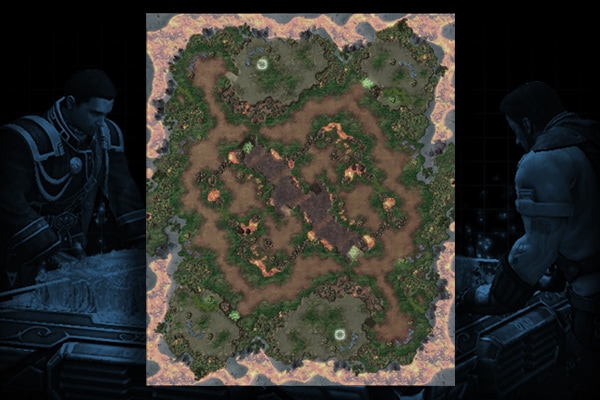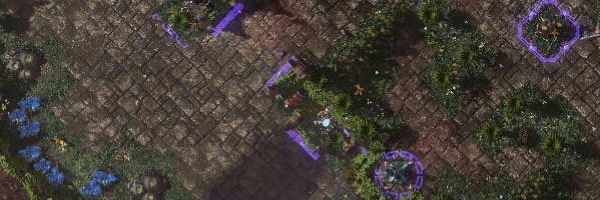Community Map Spotlight: AEM Mutiny

Over the years, we’ve seen some amazing maps created by the StarCraft II community. Map makers spend their time and passion to create fun and interesting maps for players to enjoy. Browsing through the very best, you’ll find that many of the maps have even made their way into the official ladder map pool. Cloud Kingdom, Ohana, Frost, and Habitation Station were all community made maps that were great additions in past ladder seasons. In the current season, the tradition has continued with five more community maps giving players dynamic landscapes to explore.
While the ladder pool helps provide some great exposure for these maps, there are many more maps not used in the ladder that deserve attention. To help with this, we are bringing you the Community Map Spotlight. This showcase will allow us to take a closer look at some of the best community maps and the passionate minds behind them.
Our first Community Map Spotlight focuses on a map where resources are precious and expanding towards your enemy provides benefits along with the added risk, it’s AEM Mutiny.
AEM Mutiny
While a map overview is a good way check out the map layout, lets dig a bit deeper. Our strategive overview will make it easy to check out the stats and interesting features on this map.
Strategic Overview
AEM Mutiny comes to us from Alec “Timetwister22” Cooper. We spoke with Alec to discuss his thoughts on map making and the details behind this map.
Psione: Hi, Alec. Thanks for doing this. Why don’t we start with you telling us a little bit about your experience in map making?
Timetwister22: I have been mapmaking actively within the Team Liquid melee mapmaking community for about three years now. I came into the scene as a dark horse that somehow managed to become a finalist in the first Team Liquid Map Contest with my map Havens Lagoon. My sudden and surprising entrance into the melee mapmaking scene landed me a spot on the ESV mapmaking team. The ESV mapmaking team was made up of some of the best community mapmakers, and responsible for well-known maps such as Cloud Kingdom, Ohana, and Korhal Compound. With veteran mapmakers there to lend their help, advice, and experience, I quickly found myself making quality maps and placing multiple times in additional Team Liquid Mapmaking Contests, as well as Map of the Month contests. The ESV Mapmaking Team has since fallen apart, and I now continue to make maps as a part of the AlloyE Mapworks mapmaking team.
P: You mentioned that you learned a lot from veteran map makers. What were some tips or advice they gave you that changed how you make maps?
T: Veteran mapmakers, such as Superouman, Grebliv, Ironman, Monitor, and others helped me iron out my understanding of basic map proportions. Map proportions consist of the sizing and distancing of the various map features, such as the width of certain choke points or the distances between bases. Since these are all variables that interact with one another, and change depending on the map concept, they cannot be easily taught. Instead, mapmakers have to just get a feel for good map proportions through trial and error. For me, being able to run my trials by veteran mapmakers allowed me to quickly pick up on my errors, which allowed me to master map proportions and create solid map layouts.
P: Are there any tips that you’ve learned on your own that you’d like to pass along to newer map makers?
T: Many new mapmakers, or those who find mapmaking interesting, are often scared away by the daunting complexity of the editor. To be fair, the editor is a beast, and is incredibly powerful. However, as a melee mapmaker, you don't need to know even a tenth of what the editor can do. Messing around in the editor and searching around online is primarily how I learned to use the tools I needed for melee mapmaking.
When it comes to mapmaking itself, I'd highly suggest anyone new at mapmaking to learn how to make a standard map first, and then get good at making standard maps. I've seen plenty of new mapmakers take a swing at complicated or super nonstandard ideas, which generally result in a very poorly executed map all around. After all, it is very difficult to understand how to properly break the standard, if you don't understand standard to begin with. Learning the basic map proportions and general needs to support each race and the meta-game are important first steps for anyone new to mapmaking.
If any new mapmaker needs guidance, I always suggest opening up a current or recent ladder map in the editor, and looking for a general pattern among them. Looking at the map sizes, size of the mains, choke points, and the distances between important features can be incredibly helpful for anyone looking to get started.
P: Where do you find you get most of the ideas or concepts for your maps?
T: Some of my ideas are original and just come to me from messing around in the editor. Then there are those ideas that are inspired from seeing other melee maps, or even Broodwar maps. Recently, I have been messing around with exposing mineral lines in unusual ways, similar to the high yield bases on Habitation Station. One of my maps, Ion, takes a stab at the idea.
AEM Ion
P: So speaking of your ideas and concepts for maps, let’s talk a bit about Mutiny. Can you explain some of your goals when deciding to create this map? What type of map were you looking to make?
T: When looking to create Mutiny, I really wanted to use partial bases as a primary feature. Partial bases used to be used quite often, and were seen on early GSL maps such as Crevasse and Daybreak. Since a partial base offers less mineral patches and gas geysers than a normal 8mineral 2gas base, partial bases have to lend some other sort of value to make them worth taking.
This can come in the form of extreme safety, powerful map control, or other means. Yet, it is that added value that makes partial bases incredibly fun to experiment with, because that extra value can come in dozens of forms. Thus, partial bases open up a huge variety of new map features, and have the potential to tap into a vast amount of unseen and unexplored gameplay. Mutiny stands as an attempt to tap into such unexplored gameplay.
P: There are some interesting features on this map. The third base is a half base, the far middle has four High Yield bases obstructed by rocks, and the corner bases have an extra High Yield gas geyser. Can you tell us about these features and your thoughts behind using them?
T: With Mutiny, I ran with the idea of creating a map that had a middle rich with resources, and encouraged the players to quickly progress toward and fight for the middle of the map for those extra resources. Yet, instead of just throwing gold bases in the middle of the map in which only one player could realistically hold, I looked toward a center design that allowed both players to take a stab at the resource rich middle. With those rich resources readily and reliably available, I figured players would be more inclined to create new strategies that would let them get their rich resources quickly.
Middle High Yield Minerals
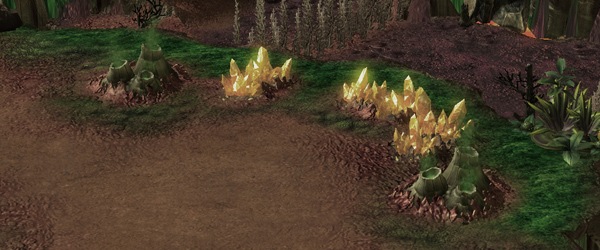
However, to further push players toward the middle of the map, I made the thirds and the bases along the main attack path partial bases. I felt if players had the opportunity to take a normal third base, they would simply stay within their comfort zone of their normal three base economy, rather than strive toward taking the central bases.Thus, I made the thirds 6 minerals 1 high yield gas partial bases to give players a reason to go beyond their three bases and expand into the middle.
Half Bases
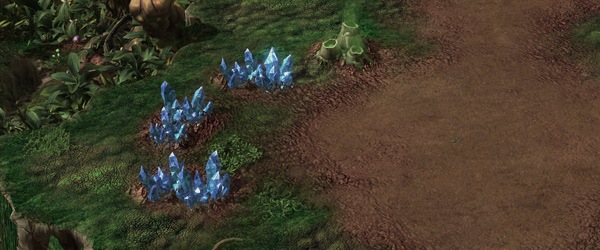
However, with the decision came a potential issue. With the thirds granting less income, and arguably less value, players may simply favor two base play instead of striving toward the middle of the map. Considering this would essentially bypass the most interesting features of the map, I looked to deter two base play. So, I made the center a long and narrow low ground path that could be easily blocked off with collapsible rock towers, and I looked to make the partial base thirds fairly easy to take and defend by keeping them close and chokey. Hopefully, these efforts will be enough to encourage players to expand into the middle of the map instead of favoring two base play.
Middle Pathway
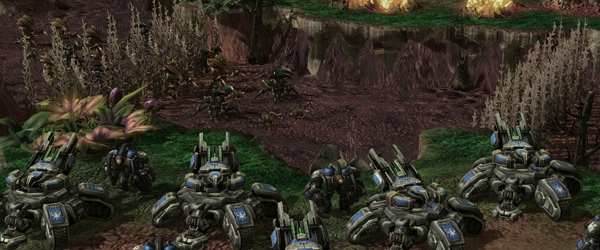
The corner bases, in many ways, are very much out of the loop. They are far away from both players, can be blocked off with collapsible rock towers, and host a normal base with the addition of a far high yield gas that takes 5-6 workers to saturate.
Corner Bases with High Yield Vespene Gas
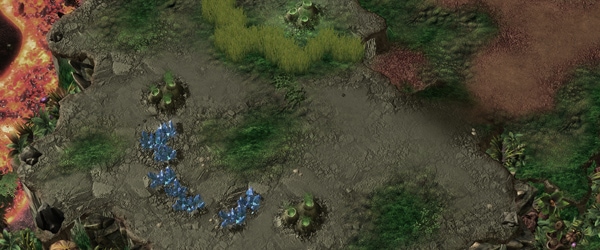
They don't exactly fit with the rest of the map, yet their role is fairly important. With the majority of the bases on the map either being partial bases or high yield bases, players will find themselves mining out on bases on Mutiny faster than on other maps. Thus, to keep the players tensely fighting over map features into the late-game, I introduced these corner bases that will help keep the late-game fights going, if they can be taken and defended. The extra gas given by the high yield geyser will help pay for those gas heavy late-game units, while the large distance between the corner bases will allow for constant back and forth late-game action. However, there always is the possibility of players looking to take these bases earlier in the game, so I added collapsible rocks to see what could come out of strategies that took the corner bases early on.
P: Which feature on Mutiny are you most excited about?
T: I am both excited, and unsure, about the interaction between the partial base thirds and the high yield bases in the middle. Considering both of these features are entirely experimental, and the fact that I tied them very closely together, I am absolutely unsure of how they will pan out in actual games. However, I can imagine some really interesting gameplay to come from these features, so I am excited to see how they pan out.
P: Are there any ideas or concepts you’d like to see more map makers explore?
T: I'm a big fan of partial bases, and the potential they have. Hopefully, Mutiny will get to showcase some of that potential. However, I'd also like to see more maps that utilize the 2-in-1 concept, as demonstrated by Waystation and Korhal Floating Island. The idea of mixing two map layouts into a single map is a really neat idea, and has some great potential to mix things up.
P: Other than this map, which of your maps are you most proud of?
T: Recently, I was able to get my 2v2 map Preservation to ladder through placing highly in the Team Liquid Map Contest. So, you could say I am fairly proud of that achievement.
P: Getting away a bit from your own maps, what are some of your all-time favorite melee maps?
T: Crevasse and Cloud Kingdom are my all-time favorites. Crevasse's use of an in-base natural and partial bases made for some really unique gameplay, while Cloud Kingdom managed to make even Broodlord/Infestor a bit more exciting. Though, I certainly enjoyed playing and watching games on Xel'naga Caverns, Shattered Temple, Habitation Station, Frost, and Whirlwind.
P: Are there any past community maps that you feel flew under the radar and people should check out?
T: Rapyuta by Superouman is a map that comes to mind. It is a four-player map that has a very cool take on third base design, as well as some stunning visuals.
Rapyuta
I was disappointed that the map didn't get much attention. I also really like Graveside by Etcetra, which is a two-player map that features a really nice execution of an in-base natural and expansion progression. Was one of my favorites during the Red Bull TL Map Contest.
If you like using unique strategies and playing on innovative maps, now's your best chance to do exactly that. AEM Mutiny offers something different that provides a fun challenge to players of any level.
We've also made the map easy to find and play. Just navigate to the Custom Games list, browse to Top Played Games and you'll find AEM Mutiny at the top of the list as a featured map.
So grab a friend, jump into a game, and have some fun.
